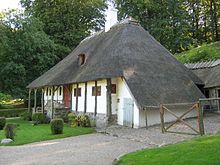Liselund
Situated near Møns Klint on the north-eastern corner of the Danish island of Møn, it is deemed to be one of the finest examples in Scandinavia of Romantic English gardening.
His father was a diplomat who after terms in Switzerland and Portugal, finally arrived in Denmark where, in 1776, the family was naturalised and recognised as Danish nobility.
[3] It was intended as a retreat where the family could spend a few days or weeks at a time, often with invited guests, away from the hardships of their working lives at Marienborg on the other side of the island.
In 1973, it was transferred to Baron Niels Henrik Rosenkranz until, owing to the increasing costs of maintaining the estate, the summer manor and park became the property of the Danish State to be administered by the National Museum of Denmark.
Then, in accordance with contemporary standards, it was landscaped and planted with a range of trees, some quite rare, including oaks, sweet chestnuts, walnuts, mulberry, spruce and cypress.
[7] In the style of the times and in order to provide a more relaxing atmosphere, several foreign-looking buildings were spread around the park, each with its own character and designed to fit a particular need.
One notable feature is the small yellow glass opening in the shutters which gave the impression of moonlight however brightly the sun might be shining outside.
Built in the Italian style and decorated with fine ceiling frescos, stucco and wall panels, the New Manor was used by the Rosenkranz family until the 1960s.
It was sold to the State in 1980 but lay empty for many years until it was bought by Krista and Steffen Steffensen in 1989 who converted it into an attractive hotel.
The park has had many well-known visitors, particularly during the period when Martha de la Calmette, Antoine's daughter-in-law, lived there as a widow for 57 years until her death in 1877.
They included the Danish Romantic poet, Adam Gottlob Oehlenschläger and the sculptor, Bertel Thorvaldsen, but the most famous of all was Hans Christian Andersen who visited the park in the summer of 1829 when he was only 24 and found it delightful.
[13][14] Baron Niels Rosenkranz who lived in the estate during World War II was head of the West Møn Danish resistance group, perhaps the first in Denmark as it was set up just a week after the German occupation on 9 April 1940.
Although the Gestapo suspected Liselund was being used as an escape route, they did not manage to find any evidence when they arrived on the night of 10 October 1943.
Niels Rosenkranz was also a key member of the group who organised the rescue of 351 ex-inmates of the Stutthof concentration camp who arrived in a river barge at nearby Klintholm Havn on 5 May 1945, the day Denmark was liberated from the Germans.











